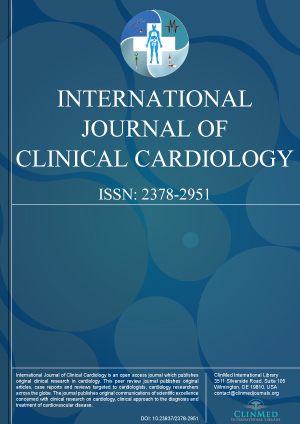Open Access DOI:10.23937/2378-2951/1410254
Coronary Artery Ectasia and Oral Anticoagulation: A Case Report
Shivum Desai, BS, Justin Dombrowski, BS and Joseph Klag, DO, FACC, FSCAI
Article Type: Case Report with Brief Literature Review | First Published: April 30, 2022
Coronary Artery Ectasia is a pathology effecting nearly 4.9% of the general population. This disease process can be found in any one of the coronary arteries and often presents in patients with comorbid conditions such as coronary artery atherosclerosis and hypertension. This combination of disease processes is often difficult to treat due to the lack of peer-reviewed data and treatment guidelines for coronary artery aneurysms. Additionally, there is currently no general consensus on the use of ...
Open Access DOI:10.23937/2378-2951/1410253
Partially Resolving Myocardial Fibrosis Five Months Following the mRNA COVID-19 Vaccine: An MRI Based Case Report
AFM Ashik Imran, DO, MBBS, Won Jun Park, MD and Michael R Sood, MD, MS
Article Type: Case Report | First Published: April 27, 2022
Myocarditis is a disease that has varying degrees of clinical manifestations. Furthermore, its diagnosis and management can pose as a challenge to clinicians. With over 250 million people receiving the mRNA covid vaccine, there have been rare reports of myocarditis, pericarditis or other cardiovascular involvement. However, its natural course remains unclear. We report a 30-year-old healthy male who was hospitalized 3 days after the second dose of the covid-19 vaccination. He had high cardiac la...
Open Access DOI:10.23937/2378-2951/1410251
STEMI during Cardiocerebral Infarction (CCI): Is it Safe to Perform Primary Percutaneous Coronary Intervention?
Thon Hon Yong, Jia Hao Jason See and Boon Wah Liew
Article Type: Case Series | First Published: April 14, 2022
Emergency percutaneous coronary intervention (PCI) is a critically important reperfusion strategy for myocardial salvage in the event of acute ST elevation myocardial infarction (STEMI). However, it poses great challenges to the treating cardiologist if there is a simultaneous acute cerebral infarction because of potential intracranial complications. Particularly, the use of dual antiplatelet and high dose anticoagulants during PCI has been well documented to increase the risk for cerebral hemor...
Open Access DOI:10.23937/2378-2951/1410252
Enlarged Left Ventricular Diastolic Dimension does not Predict Irreversible Left Ventricular Systolic Function in Patients with Atrial Arrhythmia
Hisao Matsuda, Yui Nakayama, Airi Noda, Toru Nakanishi, Dan Koto, Mizuho Kasahara, Takayuki Warisawa, Kei Mizukoshi, Makoto Takano, Koichi Mizuno, Akira Kasagawa, Tarou Suchi, Daisuke Togashi, Ikutarou Nakajima, Kenichi Sasaki, Hidekazu Miyazaki, Toshiyuki Furukawa, Tomoo Harada and Yoshihiro J Akashi
Article Type: Original Article | First Published: April 20, 2022
Atrial arrhythmia (AA) and left ventricular systolic dysfunction (LVSD) frequently co-exist, and potentially represent growing public health problems. Determining whether tachycardia is an indicator or consequence of LVSD in patients with tachycardia and LVSD is difficult. Tachycardia-mediated cardiomyopathy (TCM) raises a “chicken or egg” question. Regardless of the etiology, patients with severe LVSD are considered candidates for the implantation of a cardioverter defibrillator as primary ...

